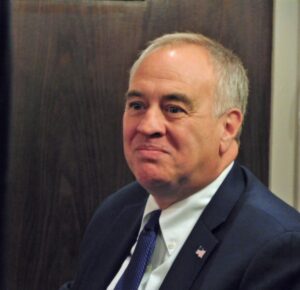NYS Comptroller: Wall Street Volatility,
Fed Funding Cuts Threaten New Budget
ALBANY—State Comptroller Thomas DiNapoli offered a major caveat to the FY2026 State Budget, which lawmakers passed last week, in two specific areas: continued turbulence on Wall Street and the threatened federal funding cuts to New York transportation funding. These two factors could have major financial implications on the state budget in the coming months, he said.
More than $90 billion of the state’s funding comes from D.C., and cuts to that funding may require adjustments to state services. According to reports, the state Legislature and governor are fully prepared to return to Albany this summer and adjust the state budget to reflect changes in federal spending.
As part of the final state budget, the Legislature also gave the governor limited authority to slash state programs if the state’s revenue decreases by $2 billion or more.

Mr. DiNapoli also pointed to a host of policy changes as part of the budget plan, including significant changes to the Foundation Aid formula, long-awaited relief to small businesses by paying off the Unemployment Insurance Trust Fund loan and reduced personal income tax rates for lower- and middle-income families starting in 2026.
Other new funding initiatives include expanding access to community college for adult learners and preserving access to childcare. The budget also fully funds the Metropolitan Transportation Authority’s $68.4-billion 2025-2029 Capital Plan.
He added that the budget includes significant state-funded increases in education, health and other spending, and it authorizes an additional $23 billion in public authority backdoor borrowing.
“General aid for local governments is largely flat, despite growing signs of fiscal strain at the local level as pandemic aid has ended and costs continue to rise,” he stated. “Deep uncertainty surrounding tariffs, the economy and actions in Washington casts a long shadow on this budget.”
He added, “Market volatility and declining business and consumer confidence may upend the state’s revenue projections and increase the already sizeable outyear budget gaps. Actions by Congress may also have a large impact on the state’s finances in the months ahead, and may jeopardize many of the critical safety net programs that New Yorkers rely on and that have always been predominantly funded by the federal government. Federal changes being considered would shift significant costs for Medicaid, food benefits and other programs to states.”
He observed that while the state has a record $8.75 billion in its statutory reserves, those funds are needed to protect against economic and fiscal disruptions, and the state does not have the resources to backfill federal reductions on an ongoing basis.
“The time to develop a strategy and structural reforms is before a crisis, yet this budget includes no serious cost containment measures, particularly in Medicaid, where it is most needed,” he warned. “In these uncertain and disruptive times, the Legislature gave extraordinary powers to the Executive to make mid-year spending cuts in the event of budget imbalance. However, this provision creates further uncertainty for those that depend on state aid.”
Published: May 13, 2025
